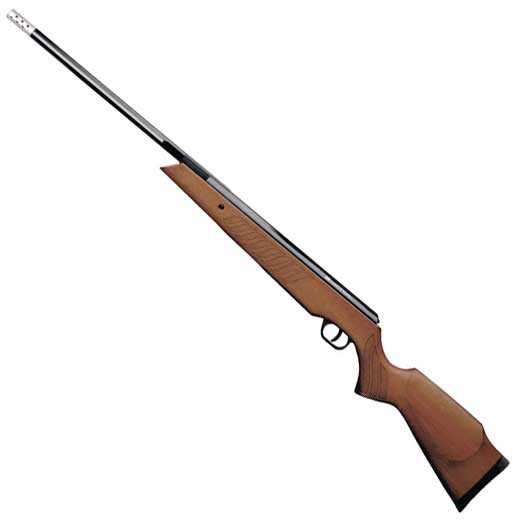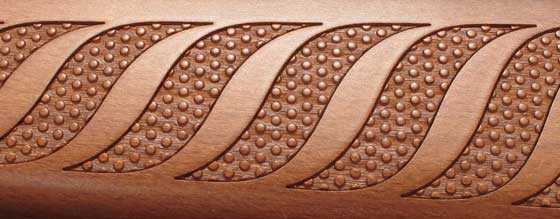by Tom Gaylord, a.k.a. B.B. Pelletier

The Cometa Fusion is a powerful breakbarrel with nice styling.
Today, we’ll start looking at a .177-caliber version of the Cometa Fusion air rifle. This is a powerful breakbarrel spring-piston rifle and the test sample is serial number 13636-10.
The Fusion is made by Cometa of Spain and imported by AirForce International. As this report is written, the list price is $334.50, so this gun is positioned against the medium-priced springers. Therefore, it needs to be accurate, have a nicer trigger and deliver on its power promise of 1,080 f.p.s. with light lead pellets. There’s an upgraded version of the rifle called the Fusion Premier Star that retails for $392.50. It has an adjustable cheekpiece but seems to be identical to the Fusion in all other ways.
The Fusion comes in both .177 caliber and .22 caliber. I have rifles in both calibers and will test one of each for you, but this is the .177. It’s a larger air rifle, at 44.80 inches overall. The pull length is 14 inches on the nose, so it’s going to fit a lot of adults. The barrel is 18-13/16 inches long, but the last 7-1/4 inches are counterbored, so the actual length is 11-9/16 inches. The silver piece on the end with holes is included in the overall length.
At about 7.5 lbs., the Fusion is a medium-weight breakbarrel. It’s light for the power and overall size.
The stock of the test gun is a dark-stained beech with a textured pistol grip and forearm. The textured areas are actually stippling, put there by a pressure-treating process.

Instead of checkering, the Fusion has stippling inside swirled sections on both the forearm and pistol grip.
The stock is close to fully ambidextrous, with just a vestigial raised cheekpiece on the left side. It’s so low and blended that it doesn’t show well in photos. The automatic safety comes straight out of the rear of the spring tube, making the rifle as ambidextrous as possible. The butt has a Monte Carlo raised comb.
The forearm has, what I would call, a field target profile, in that it’s squared-off at the bottom and flat — to rest on your palm. Though the Fusion is a large rifle, the forearm is slender enough to make the gun feel light and handy when held.
The butt is a thick matte black pad with no holes. It’s quite grippy and will hold the rifle firmly to your shoulder or when you stand it in the corner. The overall fit and finish of the wood is impeccable — rivaling the best spring guns of today.
The metal parts are finished an even matte black with silver lettering lasered on. There are just two plastic parts on the exterior of the gun — the trigger blade and the triggerguard.
The trigger is adjustable and two-stage. It currently has a lot of creep in stage two, though the pull weight is very light. I will measure it and adjust it for you in Part 2.
There are no sights, so some kind of optical sight will be needed. The scope rail is a pair of 11mm dovetail grooves machined directly into the spring tube. There are four small holes that appear to be for a vertical scope stop pin, and for reasons I haven’t figured out, either the sear or a lever it affects, can be seen through a window cut in the center of the scope rail.

Four holes atop the scope rail are for a vertical scope stop pin. There’s also a window to see the action of the sear (or the lever that restrains the piston when the gun is cocked).
When I cock the rifle, I almost get the feeling that it’s a tuned gun. The detent that holds the barrel shut is a ball-bearing, so you don’t need to slap the muzzle to open the barrel. Except for some spring noise during cocking, the rifle cocks like it’s been tuned. It’s extremely smooth and relatively light to cock; and when the sear engages, you cannot feel or hear it. The barrel just stops, and you know the rifle has been cocked.
It’s possible to uncock the gun, so there’s no anti-beartrap device in the cocking mechanism. Just take off the automatic safety and squeeze the trigger while holding the muzzle, then ride the barrel closed. Whatever you do, do not let go of the muzzle when you load this rifle, because you’re the only safety device should the sear slip.
Overall impressions
My impression from just holding the rifle and shooting a few shots into a backstop is that this is a high-quality airgun. It isn’t so difficult to cock that it challenges me, but I can tell when I shoot that it has a lot of power.
I dislike the silver muzzle piece with the holes! I think it hurts the overall look of the rifle. I do enjoy the extra few inches of leverage it affords, though, because that’s what makes the Fusion so easy to cock.
When I shoot the rifle, it feels very calm — much more than most breakbarrels of a few years ago. I can’t wait to see if the Fusion delivers the goods!

I purchased a Cometa Fusion Star about 2 years ago, and it is a fine looking rifle. Out of the box, it was very very buzzy, so I had it lube-tuned and things quieted down. In my experience, this rifle is quite hold sensitive. I’ve also had problems with poor breech lockup, as one of the thrust washers in the barrel pivot was terribly mangled right out of the box. The trigger, however, can be adjusted to a very low pull weight with a crisp break, which surprised me. Honestly, my experience with this rifle hasn’t been outstanding. I hope that Cometa has improved the rifle in recent years.
mattalizer,
Thanks for the input on the Fusion. This one isn’t very buzzy, so they may have made some improvements.
Welcome to the blog!
B.B.
Thanks a lot, Tom. I’ve been reading this blog for quite some time now. You’ve done some excellent work!
I think the idea of the counterbore is great. Flash suppressor? Well, the stippling is nice.
I don’t believe thats called a flash suppressor on a a airrifle, I think for this application it’s called an air stripper. Now whether or not it works, thats another question?
Loren
I believe that the window is not just a “window”. Part of the mechanism actually engages that slot to hold something. Hold what? I don’t remember.
If BB gets the trigger adjusted I think he’ll find it to be a very good one. When Cometa guns used to be imported by RWS (models 92, 93, and 94) it was only the 94 that had this trigger. The others each had their own unique mechanism. A bit odd, but that’s the way it was.
The part you see in the “window” is the sear that hooks the piston, a bit of an odd design but it works. Just make sure a scope mount doesn’t sit so low it blocks it….Tom, watch as you cock the rifle you will see the tail of the piston side over the sear and than latch…
Mike,
I already saw that. That was one of the first things I did with this rifle, as I was so curious about what that window was for.
B.B.
Kevin,
To get the stippling they use steam and pressure, with a reverse die against the wood stock.
B.B.
Pretty nice looking rifle. I’m not a fan of the mechanical stippling, but it doesn’t bother me either. The lines are quite sleek for an airgun, almost as nice as a D34. I wouldn’t like the open slot on the top of the tube — it does rain in windows :)! I think there might be a bit of overreaction to the flash suppressor (sorry, Kevin) — wouldn’t be the first useless gew-gaw put on an airgun so it looks more firearm like — recoil pads come to mind :)!
I guess I’m indifferent to gimmicks although I tend to dislike things that have no function whatsoever. I didn’t really care for the fake muzzle break on my Walther Nighthawk, but I formed a better opinion when I learned how it can be taped up to work as a silencer.
Matt61
This sounds like a good gun that I might buy some day if I can get a deal on it. The stippling is a nice feature I have not seen before.
The window on top looks to me like a place where foreign material can potentially get into the mechanism. Since the gun does not use open sights, it seems like a better solution for clearance would be to put a raised area on the receiver.
The silver “flash suppressor” is kind of cheesy. I would correct it with satin black spray paint.
Les
Les
That’s an air stripper on the end of the barrel, it’ supposed to smooth out the turbulent air exiting the barrel.
Loren
I don’t care. It would work just as well if it wasn’t shiny silver. I’d still paint it.
Les
Yes Les I agree it would look better black.
Loren
On the down side, unless it is very accurate with a number of pellets and has good velocity, other guns that cost a bit more would be a better buy in the long run. We will see what BB’s tests show!
Mike
It isn’t a muzzle brake, it’s an “air stripper”. Theory is that when the pellet leaves the muzzle, the air behind it can overtake it. Because there is no way to control this very little amount of air, it can affect somehow the pellet thus affecting accuracy, but only shooting at a very long distance will be noticeable. This gimmick is supposed to drive this last blow of air in a pattern well apart from the pellet. I’m not good enough to confirm or deny this assert, so take it or leave it. Maybe Tom could perform some long range shooting to test it. 🙂
I was wondering about this muzzle piece. But how in the world could air, having fallen behind in the discharge process, possibly catch up to the pellet? This seems to defy the laws of physics.
Matt61
The moment the pellet (or bullet for that matter) leaves the muzzle, starts to drag and fall. The air behind a pellet in a breakbarrel is still pouring after the pellets leaves, and in a turbulent way, but very fast. Because the pellets “hit the brakes”, some of this fast turbulent air can reach the skirt of the pellet and affect his rotation or orientation. This probably is less than a gentle breeze, but pellets are lighter and slower than firearms bullets, so even this soft touch affect them on long distance, let’s say at 10 m you see nothing, at 25-30 m you may or may not notice, and beyond 50 m makes a difference… or so they say.
Macman
Duskwight, thanks for the space gothic. That term is about right with all those iron bolts sticking out of the equipment. It reminds me of Star Trek where they are going faster than the speed of light but using those number counters that turn over. 🙂
Is your airgun development costing you a ton of money?
Matt61
Matt,
Yes, R&D eats a lot of bucks, but I still managed to keep my rifle cca $1300.
Well, it’s not a inch as beautiful as JW and it did not fire a shot yet, but considering the fact that it’s a pure R&D model, made from scratch and without established industry connections and serial production I think it’s quite an achievement. And, of course, woodwork, fitting and finishing is made by me, that also drops the price down.
duskwight